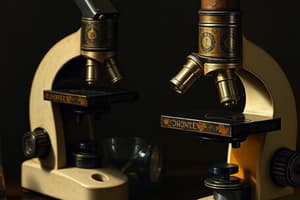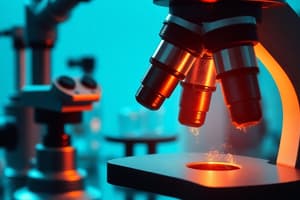Podcast
Questions and Answers
What is the significance of having a user’s manual included with the microscope?
What is the significance of having a user’s manual included with the microscope?
- It explains how to operate the microscope effectively. (correct)
- It contains specifications for different microscope models.
- It serves as a marketing tool for the manufacturer.
- It outlines warranty policies and service agreements.
Which of the following is likely to be included in a microscope user’s manual?
Which of the following is likely to be included in a microscope user’s manual?
- A list of other product lines from the manufacturer.
- Detailed instructions for assembling the microscope.
- A history of microscopy development.
- Guidelines for microscope cleaning and maintenance. (correct)
If a user is experiencing issues with their microscope, what should be their first step according to standard procedures?
If a user is experiencing issues with their microscope, what should be their first step according to standard procedures?
- Try adjusting the microscope settings randomly.
- Refer to the user’s manual for troubleshooting guidance. (correct)
- Take the microscope to a local repair shop.
- Contact the manufacturer for immediate assistance.
What might the label 'LPO – 10X' indicate in relation to a microscope?
What might the label 'LPO – 10X' indicate in relation to a microscope?
Why is it important to have accurate specifications printed in the user’s manual?
Why is it important to have accurate specifications printed in the user’s manual?
What shape should the focus be to achieve a better clarity under the microscope?
What shape should the focus be to achieve a better clarity under the microscope?
What should be done with excess stain before placing the slide on the microscopic stage?
What should be done with excess stain before placing the slide on the microscopic stage?
Why is it important to avoid mess with objective lenses when using a microscope?
Why is it important to avoid mess with objective lenses when using a microscope?
What is the first step in properly focusing an image under the microscope?
What is the first step in properly focusing an image under the microscope?
What can happen if excess stain is not wiped off before using the microscope?
What can happen if excess stain is not wiped off before using the microscope?
What is the method used to determine the field of view in a microscope with a 70 mm length?
What is the method used to determine the field of view in a microscope with a 70 mm length?
If the actual size of the specimen is 500 µm, what is the primary factor influencing the calculation of the field of view?
If the actual size of the specimen is 500 µm, what is the primary factor influencing the calculation of the field of view?
In the context of a 70 mm microscope, what unit is used to express the size of the specimen?
In the context of a 70 mm microscope, what unit is used to express the size of the specimen?
To achieve a clear view of a specimen of size 500 µm, which factor must be optimized?
To achieve a clear view of a specimen of size 500 µm, which factor must be optimized?
What does the term 'field of view' refer to in microscopy?
What does the term 'field of view' refer to in microscopy?
What is the primary function of tracheids in plants?
What is the primary function of tracheids in plants?
Which characteristic distinguishes tracheids from other cell types?
Which characteristic distinguishes tracheids from other cell types?
What type of tissue in plants do tracheids belong to?
What type of tissue in plants do tracheids belong to?
In what part of the plant are tracheids primarily found?
In what part of the plant are tracheids primarily found?
Which of the following statements about tracheids is true?
Which of the following statements about tracheids is true?
What is the primary function of lenticels in plants?
What is the primary function of lenticels in plants?
Which part of the stem is specifically defined as the segment where leaves and lateral buds are attached?
Which part of the stem is specifically defined as the segment where leaves and lateral buds are attached?
What distinguishes an internode from a node in a plant stem?
What distinguishes an internode from a node in a plant stem?
What can be observed at a leaf scar on a stem?
What can be observed at a leaf scar on a stem?
Which statement about nodes is accurate?
Which statement about nodes is accurate?
What is a defining characteristic of a plant cell compared to an animal cell?
What is a defining characteristic of a plant cell compared to an animal cell?
What function do dictyosomes (Golgi bodies) serve in a cell?
What function do dictyosomes (Golgi bodies) serve in a cell?
Which statement about the size of plant and animal cells is correct?
Which statement about the size of plant and animal cells is correct?
Which of the following best describes the structure of dictyosomes?
Which of the following best describes the structure of dictyosomes?
What is one major difference between the roles of plant cells and animal cells?
What is one major difference between the roles of plant cells and animal cells?
Flashcards
Microscope user manual
Microscope user manual
A guide for using a microscope, often provided with the product.
b.LPO-10X
b.LPO-10X
A likely microscope objective lens magnification.
Microscope sold with a manual
Microscope sold with a manual
The microscope should come with instructions.
Microscope objective lens
Microscope objective lens
Signup and view all the flashcards
User manual
User manual
Signup and view all the flashcards
Microscope Focusing
Microscope Focusing
Signup and view all the flashcards
Wipe Excess Stain
Wipe Excess Stain
Signup and view all the flashcards
Slide Placement
Slide Placement
Signup and view all the flashcards
Circular Focusing
Circular Focusing
Signup and view all the flashcards
Microscope Stage
Microscope Stage
Signup and view all the flashcards
Microscope Field of View Calculation
Microscope Field of View Calculation
Signup and view all the flashcards
Microscope Magnification
Microscope Magnification
Signup and view all the flashcards
Microscope Lens Size
Microscope Lens Size
Signup and view all the flashcards
Specimen Size
Specimen Size
Signup and view all the flashcards
Field of View
Field of View
Signup and view all the flashcards
Leaf Scar
Leaf Scar
Signup and view all the flashcards
Lenticel
Lenticel
Signup and view all the flashcards
Node
Node
Signup and view all the flashcards
Internode
Internode
Signup and view all the flashcards
What's the difference between a node and an internode?
What's the difference between a node and an internode?
Signup and view all the flashcards
Tracheids
Tracheids
Signup and view all the flashcards
Water Conduction
Water Conduction
Signup and view all the flashcards
Secondary Cell Wall
Secondary Cell Wall
Signup and view all the flashcards
Lignin
Lignin
Signup and view all the flashcards
Hardened Secondary Cell Wall Function
Hardened Secondary Cell Wall Function
Signup and view all the flashcards
Plant Cell Shape
Plant Cell Shape
Signup and view all the flashcards
What are Dictyosomes?
What are Dictyosomes?
Signup and view all the flashcards
Dictyosomes: Cell's Post Office
Dictyosomes: Cell's Post Office
Signup and view all the flashcards
Plant Cell vs. Animal Cell
Plant Cell vs. Animal Cell
Signup and view all the flashcards
Dictyosome Function
Dictyosome Function
Signup and view all the flashcards
Study Notes
Microscope Care and Maintenance
- Proper handling is crucial for microscope longevity.
- Hold the microscope by the base and arm.
- Avoid picking up the microscope by the stage or eyepiece.
- Never touch the lenses directly.
- Always use covers.
Microscope Parts and Uses
- Eyepiece Lens: Ocular lens for viewing, magnification ranges from 5X to 30X, most commonly used is 10X or 15X.
- Eyepiece Tube: Connects eyepiece and objective lenses.
- Microscope Arm: Connects eyepiece tube to base.
- Microscope Base: Provides stability and support.
- Microscope Illuminator: Light source, built-in or external (mirror reflecting light).
- Stage and Stage Clips: Platform for slides, with mechanical adjustment for precise positioning.
- Coarse Adjustment Knob: Rapidly focuses by adjusting the objective lens or stage. Used for initial focusing.
- Fine Adjustment Knob: Precisely adjusts focus for higher magnifications.
- Microscope Nosepiece: Holds objective lenses, rotating to change magnification.
- Objective Lenses: Various magnification levels (4X, 10X, 40X, 100X). Used in conjunction with the eyepiece lens to magnify the specimen. They are the lenses protruding downward over the specimen.
- Scanning lens - 4X
- LPO - 10X
- HPO - 40X
- OIO - 100X
- Rack Stop: Prevents objective lenses from damaging the slide.
- Control Focus Knobs: Adjust the distance between the stage and the lens.
Mounting Specimens
- Dry Mount: Place specimen directly on a slide, cover with coverslip.
- Wet Mount: Add a drop of water to slide, place specimen on water, cover with coverslip.
- Staining: Use staining solution to enhance specimen visibility.
Magnification and Resolution
-
Numerical Aperture (N.A.): Measures the ability of an objective lens to gather light.
-
Working Distance: Distance between the objective lens and the specimen.
-
Focal Depth: Sharpness of image.
-
Field Number: Diameter of the image field in mm.
-
Field of View Diameter (FOV): Actual size of the field of view in mm on the object surface.
-
Magnification of drawing = drawing size / object actual size in μm
Microscope Magnification Calculation
- Microscope magnification = Objective lens magnification x Ocular lens magnification
- Calculate FOV for different magnifications using ratios.
Cell Structure
- Plant Cells: Cells with fixed rectangular shape and a cell wall.
- Animal Cells: Cells in irregular shapes.
- Cell Wall: Rigid outer layer for support and structure.
- Plasma Membrane: Controls entry and exit of substances.
- Cytoplasm: Fluid portion containing organelles.
- Nucleus: Stores genetic material (DNA).
- Nucleolus: Produces ribosomes.
- Endoplasmic Reticulum: Transports materials.
- Ribosomes: Produce proteins.
- Mitochondria: Produce energy.
- Vacuoles: Storage for water, nutrients, etc.
Plant Tissues
- Parenchyma: Least specialized, thin-walled cells, support, storage, photosynthesis
- Collenchyma: Provides support.
- Sclerenchyma: More rigid cells with hardening agent, strength.
Plant Organ Systems
- Roots: Anchorage, water/mineral absorption, storage.
- Stem: Support, transport, storage.
- Leaves: Photosynthesis, transpiration.
Studying That Suits You
Use AI to generate personalized quizzes and flashcards to suit your learning preferences.
Related Documents
Description
This quiz covers essential guidelines for the care and maintenance of microscopes, emphasizing proper handling techniques to extend the life of the instrument. It also includes a summary of the various parts of a microscope and their functions, enhancing understanding of how to use this vital tool in scientific study.




